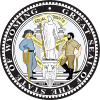
Back Wyoming Afrikaans ዋዮሚንግ Amharic Wyoming AN Hwīoming ANG وايومنغ Arabic ܘܐܝܘܡܝܢܓ ARC وايومينݣ ARY وايومنج ARZ ৱায়মিং Assamese Wyoming AST
Wyoming (/waɪˈoʊmɪŋ/ wye-OH-ming)[8] is a landlocked state in the Mountain West subregion of the Western United States. It borders Montana to the north and northwest, South Dakota and Nebraska to the east, Idaho to the west, Utah to the southwest, and Colorado to the south. With a population of 576,851 in 2020,[9] Wyoming is the least populous state despite being the 10th largest by area, with the second-lowest population density after Alaska. The state capital and most populous city is Cheyenne, which had a population of 65,132 in 2020.[10]
Wyoming's western half consists mostly of the ranges and rangelands of the Rocky Mountains; its eastern half consists of high-elevation prairie, and is referred to as the High Plains. Wyoming's climate is semi-arid in some parts and continental in others, making it drier and windier overall than other states, with greater temperature extremes. The federal government owns just under half of Wyoming's land, generally protecting it for public use. The state ranks sixth in the amount of land—and fifth in the proportion of its land—that is owned by the federal government.[11] Its federal lands include two national parks (Grand Teton and Yellowstone), two national recreation areas, two national monuments, and several national forests, as well as historic sites, fish hatcheries, and wildlife refuges.
Indigenous peoples inhabited the region for thousands of years. Historic and currently federally recognized tribes include the Arapaho, Crow, Lakota, and Shoshone. Part of the land that is now Wyoming came under American sovereignty via the Louisiana Purchase, part via the Oregon Treaty, and, lastly, via the Mexican Cession. With the opening of the Oregon Trail, the Mormon Trail, and the California Trail, vast numbers of pioneers traveled through parts of the state that had once been traversed mainly by fur trappers, and this spurred the establishment of forts, such as Fort Laramie, that today serve as population centers.[12] The Transcontinental Railroad supplanted the wagon trails in 1867 with a route through southern Wyoming,[13] bringing new settlers and the establishment of founding towns, including the state capital of Cheyenne.[14] On March 27, 1890, Wyoming became the union's 44th state.[1]
Wyoming is known for having a political culture that leans towards libertarian conservatism.[15] The Republican presidential nominee has carried the state in every election since 1968.[16] It is one of the least religious states in the country.[17] Wyoming was the first state to allow women the right to vote (not counting New Jersey, which had allowed it until 1807), and the right to assume elected office, as well as the first state to elect a female governor. In honor of this part of its history, its most common nickname is "The Equality State" and its official state motto is "Equal Rights".[1]
Farming and ranching, and the attendant range wars, feature prominently in the state's history. Wyoming's economy is largely based on tourism and the extraction of minerals such as coal, natural gas, oil, and trona. Its agricultural commodities include barley, hay, livestock, sugar beets, wheat, and wool. Wyoming does not require the beneficial owners of LLCs to be disclosed in the filing, which creates an opportunity for a tax haven. Wyoming levies no individual or corporate income tax and no tax on retirement income.
- ^ a b c "Wyoming Facts and Symbols". State of Wyoming. 2013. Archived from the original on September 20, 2016. Retrieved October 12, 2016.
- ^ CHAP. 664.—An act to provide for the admission of the State of Wyoming into the Union, and for other purposes. 26 Stat. 222. Fifty-First US Congress. Approved July 10, 1890.
- ^ "State Area Measurements and Internal Point Coordinates".
- ^ "Government of Colorado".
- ^ "Gannett Peak Cairn". NGS Data Sheet. National Geodetic Survey, National Oceanic and Atmospheric Administration, United States Department of Commerce. Retrieved October 24, 2011.
- ^ a b "Elevations and Distances in the United States". United States Geological Survey. 2001. Archived from the original on July 22, 2012. Retrieved October 24, 2011.
- ^ "Median Annual Household Income". The US Census Bureau. Archived from the original on December 20, 2016. Retrieved December 9, 2016.
- ^ "Wyoming". Merriam-Webster.com Dictionary. Merriam-Webster.
- ^ "2020 Census" (PDF). Census Bureau. April 26, 2021. Archived (PDF) from the original on April 26, 2021. Retrieved July 12, 2021.
- ^ Cite error: The named reference
QFwas invoked but never defined (see the help page). - ^ Cite error: The named reference
maineenvironment.orgwas invoked but never defined (see the help page). - ^ "Trails across Wyoming: The Oregon, Mormon Pioneer and California Routes | WyoHistory.org". www.wyohistory.org. Retrieved January 5, 2024.
- ^ "Industry, Politics and Power: the Union Pacific in Wyoming | WyoHistory.org". www.wyohistory.org. Retrieved January 5, 2024.
- ^ "Cheyenne, Magic City of the Plains | WyoHistory.org". www.wyohistory.org. Retrieved January 5, 2024.
- ^ Cohen, Micah (October 6, 2012). "Wyoming, Energy and Libertarianism". FiveThirtyEight. Retrieved September 16, 2023.
- ^ "Dave Leip's Atlas of U.S. Presidential Elections". Archived from the original on July 9, 2018. Retrieved November 18, 2016.
- ^ Green, Emma (September 6, 2017). "The 20 States Where Non-Religious People Make Up the Greatest Share of the Population". The Atlantic. Retrieved September 16, 2023.
Cite error: There are <ref group=lower-alpha> tags or {{efn}} templates on this page, but the references will not show without a {{reflist|group=lower-alpha}} template or {{notelist}} template (see the help page).


